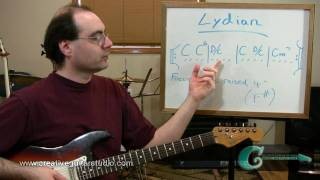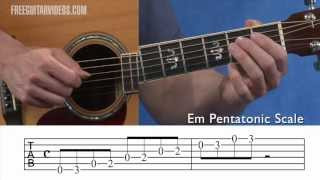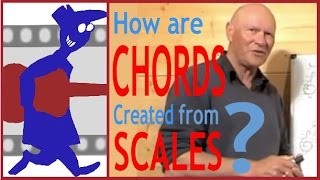Diminished Chords - How to Play them on the Guitar - Part 2
Published on 26 January 2016
If you would like to gain full access to all our Guitar Teaching Materials please visit the Secret Guitar Teacher Site and take a free tour: http://secretguitarteacher.com/youtube/ssb/Advanced/BDaYuKqbIRs/129864918-how-do-i-make-diminished-chords-2.php
Here is the abridged transcript to the video:
In part one of this mini-series we looked at how you can take shapes for the relatively familiar dominant seventh chords like E7
And by sharping the root, in this case changing the note E to F, we create a diminished seventh chord built on the new root note, in this case F dim 7th.
A quick look at the theory behind these two chord shapes soon shows us why this trick works.
The formula for a dominant seventh chord is 1 3 5 b7
This means that for E7th for example you take the 1st, 3rd, 5th and flatted 7th notes from the E Major scale
For a diminished 7th chord the formula sounds more complicated
So to make an E diminished 7th chord you take the 1st, flatted 3rd, flatted 5th and double flatted 7th notes from the E Major scale.
Now let’s take a closer look at how the two formulas compare
The diminished chord is altogether a more condensed chord, as the name ‘diminished’ perhaps suggests.
Compared to the dominant 7th, all three notes after the root note, that’s the 3rd 5th and flatted 7th are shifted down a semitone or half step.
So, looking at this on the fret board, we can perhaps see this most clearly using the D7th shape
Here’s an E7 using a D7 shape. If I keep the root as the note E, here at fret two on the D string I can change this to E dim 7 by sliding the remaining three notes down a fret like this
But, in practice, it’s often a more useful approach to think of this comparison
Here, rather than comparing E7 with E dim 7th we are comparing E7 with F dim seventh. Notice that in this case we keep the 3rd 5th and flat 7th notes in the key of E where they are, and simply shift the root note up a semitone or half step.
Having moved the root we now have to reassess the notes relative to the key of F Major so we analyse their position on the F Major scale.
Having effectively moved our benchmark up a semitone, the 3rd now becomes the flatted 3rd, the 5th becomes the flatted 5th and the flatted 7th becomes the double flatted 7th.
Here we show the reference scales in red of E major at the top of the screen and F major at the bottom. Note that Ab - the flatted 3rd in the key of F is an enharmonic equivalent - a note that sounds the same,
but has a different name - of G# - the natural 3rd in the key of E major.
Similarly Cb, as the flatted 5th in the key of F sounds the same as B the 5th in the key of E, and Ebb, the double flatted 7th in F sounds the same as D which is the flatted 7th in E.
Well I did promise you that the explanation would sound complicated! But lets look at this on the fret board, where fortunately everything is a little simpler.
So just now we looked at turning E 7th into E dim by sliding these three notes back a step
But what we have just been over works the other way - we keep these three notes where they are and simply move the root note up a step. Thus changing from E7 to F dim 7th
And a bonus you get from thinking that way round - apart from its simplicity of application - is that this is one of the ways diminished chords are used.
As a substitute for a chord rooted a semitone below. We’ll take a closer look at that in the next secret sound bite.
If you found this little video useful, please click on the ‘Like’ button, if there is one, and do feel free to share the video with your friends.
And if you’d like to gain full access to all our guitar teaching materials please visit the Secret Guitar Teacher website and
take a free look round at what’s available there.
See you again soon!
 Guitar Scales For Beginners Part 2
Guitar Scales For Beginners Part 2
 RobbieCalvoGuitar.com - D Dorian Lesson
RobbieCalvoGuitar.com - D Dorian Lesson
 Open Chords Pt 2 - D, A, & E Major - Guitar Lesson...
Open Chords Pt 2 - D, A, & E Major - Guitar Lesson...
 Lydian Mode: Part 2 - Modal Progressions
Lydian Mode: Part 2 - Modal Progressions
 SONGWRITING: Methods of Modulation
SONGWRITING: Methods of Modulation
 How to arrange a song on guitar
How to arrange a song on guitar
 How to Play Guitar Scales
How to Play Guitar Scales
 Minor Triad Voicings
Minor Triad Voicings
 Mixing Chords And Licks Parts 1&2.mov
Mixing Chords And Licks Parts 1&2.mov
 The Chromatic Scale
The Chromatic Scale







